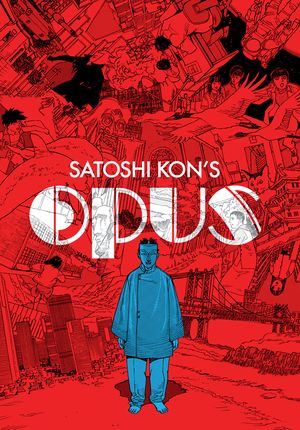Manga Monday: Satoshi Kon’s Opus
11/24/2014 4:26pm
When the brilliant Satoshi Kon died in 2010 at the age of 46, it was first and foremost a loss of a human being, someone loved by his family and friends. But of course, Kon had also been known to people around the world he never met, through the anime he directed—four films: Perfect Blue, Millennium Actress, Tokyo Godfathers and Paprika, and one television series, Paranoia Agent. Lesser known is the fact that before Kon began directing anime, he had already honed his graphic storytelling skills to a high level as one of Japan’s most talented manga artists. Dark Horse is honored this week to release his last long-form manga from that era, the 380-page Satoshi Kon’s OPUS.
Satoshi Kon wrote and drew OPUS in 1995-96, when he was preparing to make his first movie, and it resonates with his trademark themes of reality, fantasy, perception, and the role of the creator. Do you remember in that scene in Perfect Blue where you see a strange mask on the wall when Mima is dreaming (?) about the murder of the photographer? It’s the one worn by the antagonist in OPUS; you can see it in this 12-page preview here.
The OPUS manga begins with what is seemingly another manga entirely, entitled Resonance, about a mind-reading cop named Satoko in a showdown with a telekinetic cult leader called The Masque. The manga is presented the way it would look in a Japanese magazine, with intro pages in color and sidebars explaining the characters and asking for reader feedback. But Resonance soon breaks down to black-and-white pages, and then rough pencil layouts…and then we see a guy showing the layouts to an editor, and realize Resonance is just a manga that exists within the actual story of OPUS—a story about Resonance’s creator, Chikara Nagai, who’s struggling to finish the final chapter by the magazine’s deadline.
Unfortunately for Nagai, it turns out that Resonance isn’t “just a manga,” and “it exists” for real—and before he knows it, he’s drawn into Resonance, where he discovers the characters in the manga think of it as their world, and aren’t too pleased (or impressed) to meet their creator! That’s only the beginning of the metafictional journey of OPUS—a funny and ironic look at the manga industry as well as a serious meditation on the limits and responsibilities of a creator, all drawn in a detailed, fast-paced style reminiscent of AKIRA (on which Kon was an art assistant to Katsuhiro Otomo). Dark Horse takes pride in being able to publish the best comics creators in the world, and it’s a great privilege to say that this week, we can add Satoshi Kon’s OPUS to our library. Add it to yours!
—Carl Horn
Manga Editor
 When the brilliant Satoshi Kon died in 2010 at the age of 46, it was first and foremost a loss of a human being, someone loved by his family and friends. But of course, Kon had also been known to people around the world he never met, through the anime he directed—four films: Perfect Blue, Millennium Actress, Tokyo Godfathers and Paprika, and one television series, Paranoia Agent. Lesser known is the fact that before Kon began directing anime, he had already honed his graphic storytelling skills to a high level as one of Japan’s most talented manga artists. Dark Horse is honored this week to release his last long-form manga from that era, the 380-page Satoshi Kon’s OPUS.
When the brilliant Satoshi Kon died in 2010 at the age of 46, it was first and foremost a loss of a human being, someone loved by his family and friends. But of course, Kon had also been known to people around the world he never met, through the anime he directed—four films: Perfect Blue, Millennium Actress, Tokyo Godfathers and Paprika, and one television series, Paranoia Agent. Lesser known is the fact that before Kon began directing anime, he had already honed his graphic storytelling skills to a high level as one of Japan’s most talented manga artists. Dark Horse is honored this week to release his last long-form manga from that era, the 380-page Satoshi Kon’s OPUS.
Satoshi Kon wrote and drew OPUS in 1995-96, when he was preparing to make his first movie, and it resonates with his trademark themes of reality, fantasy, perception, and the role of the creator. Do you remember in that scene in Perfect Blue where you see a strange mask on the wall when Mima is dreaming (?) about the murder of the photographer? It’s the one worn by the antagonist in OPUS; you can see it in this 12-page preview here.
The OPUS manga begins with what is seemingly another manga entirely, entitled Resonance, about a mind-reading cop named Satoko in a showdown with a telekinetic cult leader called The Masque. The manga is presented the way it would look in a Japanese magazine, with intro pages in color and sidebars explaining the characters and asking for reader feedback. But Resonance soon breaks down to black-and-white pages, and then rough pencil layouts…and then we see a guy showing the layouts to an editor, and realize Resonance is just a manga that exists within the actual story of OPUS—a story about Resonance’s creator, Chikara Nagai, who’s struggling to finish the final chapter by the magazine’s deadline.
Unfortunately for Nagai, it turns out that Resonance isn’t “just a manga,” and “it exists” for real—and before he knows it, he’s drawn into Resonance, where he discovers the characters in the manga think of it as their world, and aren’t too pleased (or impressed) to meet their creator! That’s only the beginning of the metafictional journey of OPUS—a funny and ironic look at the manga industry as well as a serious meditation on the limits and responsibilities of a creator, all drawn in a detailed, fast-paced style reminiscent of AKIRA (on which Kon was an art assistant to Katsuhiro Otomo). Dark Horse takes pride in being able to publish the best comics creators in the world, and it’s a great privilege to say that this week, we can add Satoshi Kon’s OPUS to our library. Add it to yours!
—Carl Horn
Manga Editor



